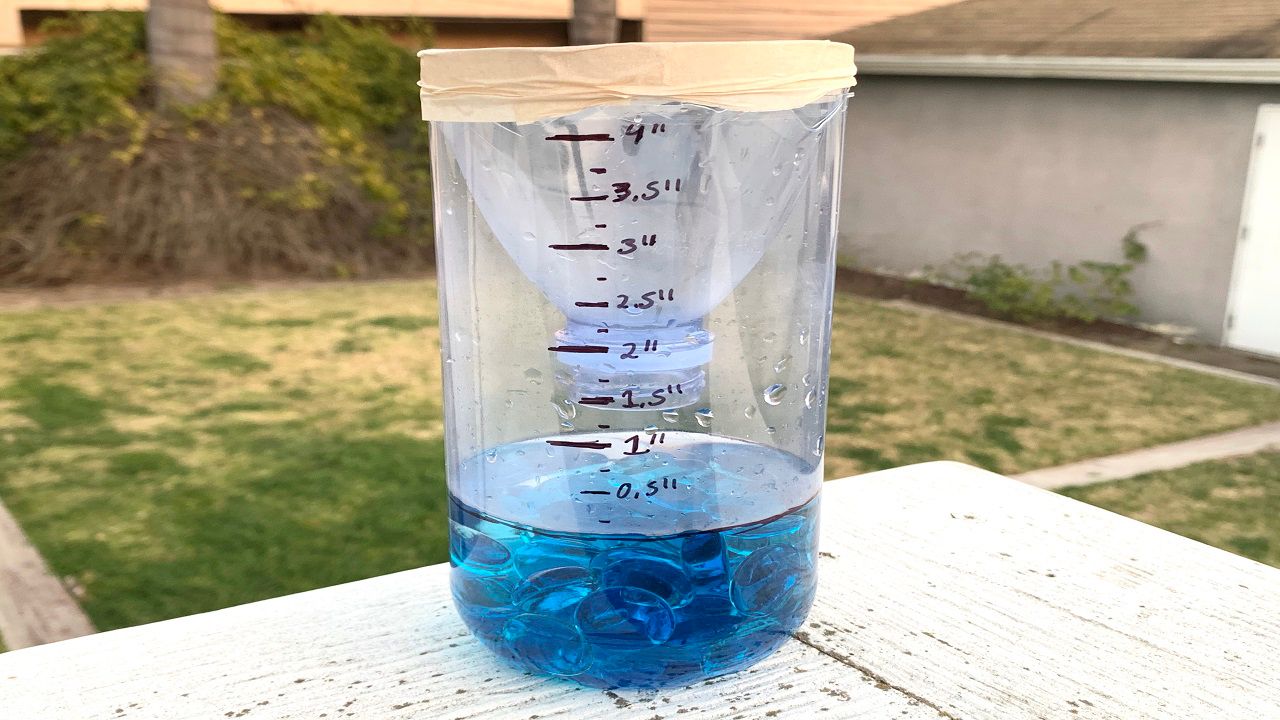Once a storm passes, have you ever wondered how much rain fell in your neighborhood, or is that just me?
Sure, you can access the rain totals from local airports or from information the National Weather Service provides, but why not make it a fun exercise in your backyard?
I’m going to show you how to build a rain gauge in 10 easy steps so you can measure rainfall wherever and whenever you want, assuming there’s rain in the forecast.
Grab the materials that you will need.
Use the scissors to cut off the top portion of the plastic bottle and set it aside for now.
Turn the bottle on its side to make some measurement markings with the permanent marker.
For reference, let’s measure from the bottom up about 2 inches and draw a horizontal line around the entire bottle. This line will be your starting point for measuring the precipitation.
Underneath that line is where you will put stones and water to anchor the rain gauge to prevent it from tipping during a storm.
From there, line up the bottom of the ruler with the starting line.
Use the Sharpie to mark every quarter-inch, and label each marking.
Put a handful of rocks/pebbles/marbles into the bottom of the bottle and fill it with water until it reaches the starting line.
This will help calibrate the rain gauge and even everything out. From that point, you can measure how much rain accumulates.
Take the top portion of the water bottle (toss the cap out) and place it upside down inside the open water bottle to create a funnel.
Use tape to connect both pieces and help keep the funnel in place.
On a day where rain is in the forecast, place the rain gauge outside in an open area away from objects that could affect it.
After the storm passes, observe how much rainfall your gauge collected and record it. You can always put it into a spreadsheet and keep track of each storm every time you receive rain in your backyard. Compare it with the rain totals we report on Spectrum News.
Reset everything by emptying all the water and rocks inside the bottle. Put rocks back in the bottom, and add water to the starting line. Place the bottle outside on every rainy day in the future to track the rainfall.
Where you put your rain gauge is an important factor when considering the accuracy.
You will want to place it away from the house because you don’t want the house to block rain from falling into it. Besides that, you want to avoid all obstacles, such as other buildings, trees and fences.
Also, make sure you keep it away from roofs, gutters or any other surfaces that can dump excess water and skew the reading.
One mistake I made in the past is I had the rain gauge out on my lawn and didn’t realize my sprinklers were set to turn on. Make sure you turn off your sprinklers if there is a wet storm moving through - rain is Mother Nature’s natural sprinkler.
Look around you when figuring out where to place the rain gauge. You will want to put it in a space that is wide open and away from other objects, which, for most, is usually the center of your front yard or backyard.
Here are some perks of measuring rainfall:
- You can keep track of soil moisture. If you want to save some money on your water bill beginning with outside landscaping, this is the place to start. You’ll know how much water your lawn and plants receive anytime a storm passes over your home. This can help you avoid over watering and overpaying.
- By watching the amount of rain falling in your area, you can stay aware of the potential for flooding.
- It can help you become an expert gardener. I know many people these days that grow fruits and veggies in their backyard. Measuring and paying attention to rainfall is one part of the gardening process to ensure your crops get enough nutrients and yield the best products.
- It’s a fun activity for the entire family, and it helps you understand weather trends and rainfall patterns in your neighborhood.
Our team of meteorologists dives deep into the science of weather and breaks down timely weather data and information. To view more weather and climate stories, check out our weather blogs section.



